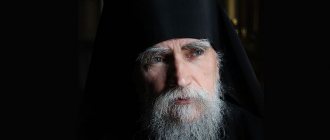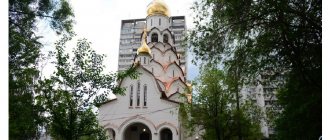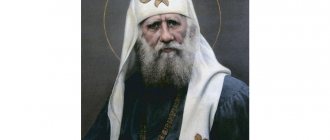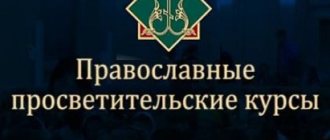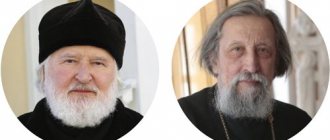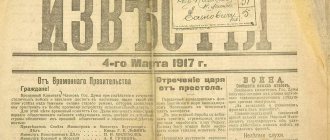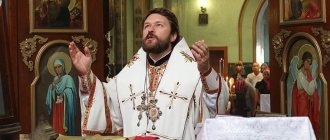Beloved in the Lord, servants of the Altar of the Lord, dear brothers and sisters!
We are all witnesses to the great miracle of the revival of the Russian Orthodox Church. Many of us know firsthand about the trials that our Russian Church went through in the past twentieth century. Persecutions of unprecedented scale befell Her, countless sacrifices were made by Her children for the sake of Christ.
What lesson can we learn from what the Church of Christ experienced in the twentieth century? Hieromartyr Hilarion, Archbishop of Vereisky, can answer for us: “During these years, my faith in the Church only grew stronger and my heart was confirmed in hope in God... When so many of human affairs turned out to be built on quicksand... The Church of God stands unshakably, only adorned, as if purple and fine linen, the blood of new martyrs. What we knew from church history, what we read about from the ancients, we now see with our own eyes: the Church wins when it is harmed... We not only believe, but we also see that the gates of hell are powerless before God’s eternal creation. Among the winds of false teachings, among the muddy furious waves of anger, lies and slander of frantic enemies, the Church stands like a rock...”
The canonization of the new martyrs and confessors of the Russian twentieth century, carried out by the Bishops' Jubilee Council in August 2000, is undoubtedly one of the greatest events in the entire history of the Russian Orthodox Church. To us, eyewitnesses of this event, it may not yet be entirely clear what spiritual prospects are opening up for us in recognizing the feat of an innumerable host of ascetics of the faith.
Among the difficulties of modern life in Russian society, surrounded by godlessness, heterodoxy and sectarianism, schisms and heresies, despite the propaganda of evil, violence, money-grubbing, unprecedented depravity and new, previously unimaginable temptations, in the face of still unknown trials of the coming 21st century, the Russian Orthodox Church summed up its spiritual experience over the twentieth century. With the blood of its martyrs, the Russian Church prepared itself to enter the third millennium.
Our grateful acceptance of this experience of holiness can unite us again. Pointing to the host of saints of modern times and calling to seek their prayerful intercession, the Church fulfills its maternal duty towards the people who expect sanctification from Her.
“Glorifying the feat of the new martyrs, the Russian Orthodox Church trusts in their intercession and prays that the Lord will add His mercy to us and give all our compatriots time to repent, ignite in their hearts the fire of faith, zeal for the revival of Holy Rus', our earthly Fatherland.”
I wish all readers to be inflamed with zeal for salvation and hope for God’s help in the difficult circumstances of our lives. Through the prayers of the new martyrs and confessors of Russia in the 20th century, may the Lord grant us to work for the glory of God and the Church of Christ for eternal salvation.
With love in the Lord, Metropolitan of Krutitsky and Kolomna Chairman of the Synodal Commission for the Canonization of Saints
Collection - Lives of the Russian New Martyrs and Confessors of the 20th Century
1 …319
Lives of the Russian New Martyrs and Confessors of the 20th Century
Beloved in the Lord, servants of the Altar of the Lord, dear brothers and sisters!
We are all witnesses to the great miracle of the revival of the Russian Orthodox Church. Many of us know firsthand about the trials that our Russian Church went through in the past twentieth century. Persecutions of unprecedented scale befell Her, countless sacrifices were made by Her children for the sake of Christ.
What lesson can we learn from what the Church of Christ experienced in the twentieth century? Hieromartyr Hilarion, Archbishop of Vereisky, can answer for us: “During these years, my faith in the Church only grew stronger and my heart was confirmed in hope in God... When so many of human affairs turned out to be built on quicksand... The Church of God stands unshakably, only adorned, as if purple and fine linen, the blood of new martyrs. What we knew from church history, what we read about from the ancients, we now see with our own eyes: the Church wins when it is harmed... We not only believe, but we also see that the gates of hell are powerless before God’s eternal creation. Among the winds of false teachings, among the muddy furious waves of anger, lies and slander of frantic enemies, the Church stands like a rock...”
The canonization of the new martyrs and confessors of the Russian twentieth century, carried out by the Bishops' Jubilee Council in August 2000, is undoubtedly one of the greatest events in the entire history of the Russian Orthodox Church. To us, eyewitnesses of this event, it may not yet be entirely clear what spiritual prospects are opening up for us in recognizing the feat of an innumerable host of ascetics of the faith.
Among the difficulties of modern life in Russian society, surrounded by godlessness, heterodoxy and sectarianism, schisms and heresies, despite the propaganda of evil, violence, money-grubbing, unprecedented depravity and new, previously unimaginable temptations, in the face of still unknown trials of the coming 21st century, the Russian Orthodox Church summed up its spiritual experience over the twentieth century. With the blood of its martyrs, the Russian Church prepared itself to enter the third millennium.
Our grateful acceptance of this experience of holiness can unite us again. Pointing to the host of saints of modern times and calling to seek their prayerful intercession, the Church fulfills its maternal duty towards the people who expect sanctification from Her.
“Glorifying the feat of the new martyrs, the Russian Orthodox Church trusts in their intercession and prays that the Lord will add His mercy to us and give all our compatriots time to repent, ignite in their hearts the fire of faith, zeal for the revival of Holy Rus', our earthly Fatherland”[1 ].
I wish all readers to be inflamed with zeal for salvation and hope for God’s help in the difficult circumstances of our lives. Through the prayers of the new martyrs and confessors of Russia in the 20th century, may the Lord grant us to work for the glory of God and the Church of Christ for eternal salvation.
With love in the Lord, Metropolitan of Krutitsky and Kolomna Chairman of the Synodal Commission for the Canonization of Saints
From the compilers
The first book of the multi-volume edition “Lives of the New Martyrs and Confessors of Russia in the 20th Century of the Moscow Diocese” includes biographies of 62 ascetics glorified at the Council of New Martyrs and Confessors of Russia.
The order in which the lives are arranged in the collection is determined by the ancient hagiographic tradition. All lives are placed in chronological order according to the days of memory of the ascetics. This volume included the lives of those whose memory fell on the months of January and May inclusive.
Within each month, the lives are distributed according to the dates of memory, which are indicated according to the old style, and the civil new style is indicated in brackets. The day of remembrance may not coincide with the actual day of death of the ascetic if the death occurred on the day of the Twelfth or another great holiday. In this case, the saint's memory is postponed to another day.
The memory of each ascetic, according to the Determination of the Jubilee Council of Bishops on the canonization of new martyrs and confessors of the Russian twentieth century, is celebrated on the day of death and on the day of celebration of the Council of New Martyrs and Confessors of Russia on January 25 (February 7), if this day coincides with a Sunday, and if this day does not coincide with a Sunday, then on the nearest Sunday after January 25 (February 7).
For some martyrs and confessors, it has not yet been possible to establish the exact day of death, therefore their memory is celebrated only on the day of the Council of New Martyrs and Confessors of Russia.
Some ascetics are united in one life due to the fact that they served in the same church or deanery and (or) were arrested in the same case. They also could have suffered more than one day, but their memory, according to church tradition, is celebrated together on one day.
In most cases, photographs of martyrs and confessors were found. They are published in this collection along with the life. Since the work of creating icons is still waiting for its diligent icon painters, the compilers of the collection express the hope that this material will be an invaluable help for them.
Work to identify new names of new martyrs and confessors of Russia continues. The Bishops' Jubilee Council of 2000 determined: “In the post-conciliar period, the inclusion by name of the new martyrs and confessors of Russia into the already glorified Council should be carried out with the blessing of His Holiness the Patriarch and the Holy Synod, on the basis of preliminary studies carried out by the Synodal Commission for the Canonization of Saints” (clause 14 of the Act on the Conciliar Glorification New Martyrs and Confessors of Russia). This collection included the lives of those who were glorified at the Jubilee Council of Bishops in 2000, as well as the new martyrs and confessors of Russia who were included in the Council in the post-conciliar period on the basis of the decisions of the Holy Synod in 2000 and 2001.
At the end of the book, as an appendix, there is a list of saints whose lives are included in this collection, indicating the time of inclusion of their name in the Council of New Martyrs and Confessors of Russia in the 20th century.
You can send your comments, suggestions and additions to the address: 119 435 Moscow, Novodevichy proezd 1, Synodal Commission for the Canonization of Saints.
LIST OF ABBREVIATIONS
AMP Archive of the Moscow Patriarchate
GAKO State Archive of the Kostroma Region
GARF State Archives of the Russian Federation
OR RSL Department of Manuscripts of the Russian State Library
PSTBI Orthodox St. Tikhon's Theological Institute
RGALI Russian State Archive of Literature and Art
RGIA Russian State Historical Archive
Central Archive of the FSB Central Archive of the FSB
TsGAMO Central State Archive of the Moscow Region CIAM Central Historical Archive of Moscow TsMAM Central Municipal Archive of Moscow
January–May
January 4 (17) Hieromartyr Pavel (Felitsyn)
Compiled by S. N. Romanova
Hieromartyr Pavel was born in 1894 into the family of priest John Felitsyn. At that time they lived in the village of Karpovo, Dmitrov district, Moscow province.
After graduating from school and vocational school, Pavel Ivanovich was drafted into the army, where he served as a private from 1915 to 1916. In 1916 he was captured by Austria and remained there until 1918.
In 1923, a lot changed in the life of Pavel Ivanovich. His father died, and that same year, despite the unfolding persecution of the Church, he became a priest.
Initially, Father Pavel’s place of service was the village of Gorki, Dmitrovsky district, Moscow region, and from 1931 he began to serve in the village of Leonovo, Rostokinsky district (now the territory of Moscow) in the Church of the Deposition of the Robe. Father Pavel did not have his own family, his own home; he rented an apartment from the widow of the priest of the village of Leonovo, Alexandra Ivanovna Smirnova.
Priest Pavel was arrested on November 15, 1937 on charges of anti-Soviet agitation and imprisoned in Tagansk prison. During the interrogation, the investigator asked:
— What church do you belong to?
— I belong to the Tikhonov Church.
- The investigation knows that you carried out counter-revolutionary agitation in Smirnova’s apartment... do you admit that this was so or not?
“No, that didn’t happen... I didn’t conduct any counter-revolutionary agitation against the Soviet regime,” answered the priest.
On December 5, 1937, the NKVD Troika sentenced priest Pavel Felitsyn to 10 years in a forced labor camp, where he died on January 17, 1941. The place of his death and burial is unknown.
SOURCES: GARF. F. 10035, house P-30358.
January 18 (31) Hieromartyr Nicholas (Krasovsky)
1 …319
From the compilers
The first book of the multi-volume edition “Lives of the New Martyrs and Confessors of Russia in the 20th Century of the Moscow Diocese” includes biographies of 62 ascetics glorified at the Council of New Martyrs and Confessors of Russia.
The order in which the lives are arranged in the collection is determined by the ancient hagiographic tradition. All lives are placed in chronological order according to the days of memory of the ascetics. This volume included the lives of those whose memory fell on the months of January and May inclusive.
Within each month, the lives are distributed according to the dates of memory, which are indicated according to the old style, and the civil new style is indicated in brackets. The day of remembrance may not coincide with the actual day of death of the ascetic if the death occurred on the day of the Twelfth or another great holiday. In this case, the saint's memory is postponed to another day.
The memory of each ascetic, according to the Determination of the Jubilee Council of Bishops on the canonization of new martyrs and confessors of the Russian twentieth century, is celebrated on the day of death and on the day of celebration of the Council of New Martyrs and Confessors of Russia on January 25 (February 7), if this day coincides with a Sunday, and if this day does not coincide with a Sunday, then on the nearest Sunday after January 25 (February 7).
For some martyrs and confessors, it has not yet been possible to establish the exact day of death, therefore their memory is celebrated only on the day of the Council of New Martyrs and Confessors of Russia.
Some ascetics are united in one life due to the fact that they served in the same church or deanery and (or) were arrested in the same case. They also could have suffered more than one day, but their memory, according to church tradition, is celebrated together on one day.
In most cases, photographs of martyrs and confessors were found. They are published in this collection along with the life. Since the work of creating icons is still waiting for its diligent icon painters, the compilers of the collection express the hope that this material will be an invaluable help for them.
Work to identify new names of new martyrs and confessors of Russia continues. The Bishops' Jubilee Council of 2000 determined: “In the post-conciliar period, the inclusion by name of the new martyrs and confessors of Russia into the already glorified Council should be carried out with the blessing of His Holiness the Patriarch and the Holy Synod, on the basis of preliminary studies carried out by the Synodal Commission for the Canonization of Saints” (clause 14 of the Act on the Conciliar Glorification New Martyrs and Confessors of Russia). This collection included the lives of those who were glorified at the Jubilee Council of Bishops in 2000, as well as the new martyrs and confessors of Russia who were included in the Council in the post-conciliar period on the basis of the decisions of the Holy Synod in 2000 and 2001.
At the end of the book, as an appendix, there is a list of saints whose lives are included in this collection, indicating the time of inclusion of their name in the Council of New Martyrs and Confessors of Russia in the 20th century.
You can send your comments, suggestions and additions to the address: 119 435 Moscow, Novodevichy proezd 1, Synodal Commission for the Canonization of Saints.
- Lives of the Odintsovo New Martyrs
By the decision of the Council of Bishops of the Russian Orthodox Church in 2000, the glorification of the Council of New Martyrs and Confessors of Russia took place, including more than a thousand names of sufferers who gave their lives for the faith of Christ.
Every year on the Sunday closest to January 25 (Old Art.), the Church celebrates the Council of New Martyrs and Confessors of Russia. The martyrs were the first Christian saints, and it is they who make up the majority in the host of all the saints of the Orthodox Church. However, for almost a thousand years of its history, the Russian Church, with the exception of isolated cases, has not known martyrs for the faith. Their time in Rus' came only in the 20th century. Archpriest M. Polsky wrote in the middle of the century: “We have a great and glorious army of new sufferers. Infants and youths, elders and adults, princes and simpletons, men and wives, saints and shepherds, monks and laity, kings and their subjects formed the great council of Russian new martyrs, the glory of our Church... As part of the Universal Church, the Russian Church is the youngest and does not know in its history of mass persecution from paganism and heresies, but for that on its field the Universal Church received heavy blows from atheism. Our Church not only filled the gap in its history and, not at the beginning, but at the end of its thousand-year existence, accepted the martyrdom that it lacked, but also completes the general feat of the Universal Church, begun by Rome and continued by Constantinople.”
The persecution began shortly after the October Revolution of 1917. Archpriest John Kochurov of Tsarskoye Selo became the first martyr of the Russian clergy. On November 8, 1917, Father John prayed with parishioners for the pacification of Russia. In the evening, revolutionary sailors came to his apartment. After the beatings, the half-dead priest was dragged along the railroad tracks for a long time until he died... On January 29, 1918, sailors shot Metropolitan Vladimir in Kyiv - this was the first martyr among the bishops. Following the holy martyrs John and Vladimir, others followed. The cruelty with which the Bolsheviks put them to death could be envied by the executioners of Nero and Domitian. In 1919 in Voronezh, in the monastery of St. Mitrofan, seven nuns were boiled alive in cauldrons with boiling resin. A year earlier, three priests in Kherson were crucified on crosses. In 1918, Bishop Feofan (Ilyinsky) of Solikamsk, in front of the people, was taken out onto the frozen Kama River, stripped naked, braided his hair, tied it together, then, having threaded a stick through it, he lifted it into the air and began to slowly lower it into the ice hole and lift until he, still alive, is covered with a crust of ice two fingers thick.
Bishop Isidore Mikhailovsky (Kolokolov) was put to death in a no less brutal way. In 1918 in Samara he was impaled. The death of other bishops was terrible: Bishop Andronik of Perm was buried alive in the ground; Archbishop of Astrakhan Mitrofan (Krasnopolsky) was thrown from the wall; Archbishop Joachim (Levitsky) of Nizhny Novgorod was hanged upside down in the Sevastopol Cathedral; Bishop Ambrose (Gudko) of Serapul was tied to the tail of a horse and let it gallop... The death of ordinary priests was no less terrible. The priest Father Koturov was poured with water in the cold until he turned into an ice statue... The seventy-two-year-old priest Pavel Kalinovsky was beaten with whips... The supernumerary priest Father Zolotovsky, who was already in his ninth decade, was dressed in a woman’s dress and taken to the square. The Red Army soldiers demanded that he dance in front of the people; when he refused, he was hanged... The priest Joakim Frolov was burned alive outside the village on a haystack...
As in ancient Rome, executions were often carried out on a massive scale. From December 1918 to June 1919, seventy priests were killed in Kharkov. In Perm, after the city was occupied by the White Army, the bodies of forty-two clergy were discovered. In the spring, when the snow melted, they were found buried in the seminary garden, many with signs of torture. In Voronezh in 1919, 160 priests were simultaneously killed, led by Archbishop Tikhon (Nikanorov), who was hanged on the Royal Doors in the church of the monastery of St. Mitrophan of Voronezh... Mass murders occurred everywhere: information about executions in Kharkov, Perm and Voronezh has only reached us because these cities were occupied by the white army for a short time. Both old people and very young people were killed for their mere membership in the clergy. In 1918 there were 150 thousand clergy in Russia. By 1941, 130 thousand of them were shot.
Among the people, veneration of the new martyrs arose immediately after their death. In 1918, Saints Andronik and Theophan were killed in Perm. The Moscow Council sent a commission headed by Archbishop Vasily of Chernigov to investigate the circumstances of the death of the Perm bishops. When the commission was returning to Moscow, Red Army soldiers burst into the carriage between Perm and Vyatka. Bishop Vasily and his companions were killed, and their bodies were thrown from the train. The peasants buried the dead with honor, and pilgrims began to go to the grave. Then the Bolsheviks dug up the bodies of the martyrs and burned them. The bodies of the holy royal martyrs were also carefully destroyed. The Bolsheviks understood perfectly well what their sluggishness could lead to. It is no coincidence that the security officers categorically refused to hand over the bodies of those executed for religious beliefs to relatives and friends. It was not by chance that the means of execution were chosen in which the bodies of the martyrs were not preserved (drowning, burning). The experience of Rome came in handy here. Here are just a few examples. Bishop Hermogenes of Tobolsk was drowned in the Tura River on June 16, 1918, with a two-pound stone tied to his twisted hands. The body of the executed Serpukhov Archbishop Arseny was covered with chlorocarbon lime. The bodies of the Petrograd martyrs Metropolitan Veniamin, Archimandrite Sergius, Yuri and John were destroyed (or hidden in an unknown place). The body of Tver Archbishop Thaddeus, a great righteous man and ascetic who was considered a saint during his lifetime, was shot in 1937, and was secretly buried in a public cemetery. The body of Belgorod Bishop Nikodim was thrown into a common execution pit. (However, Christians found out about this and served funeral services at that place every day).
Sometimes the Orthodox were able to redeem the relics. In the village of Ust-Labinskaya on February 22, 1922, priest Mikhail Lisitsyn was killed. For three days they led him around the village with a noose around his neck, mocked him and beat him until he stopped breathing. The body of the martyr was bought from the executioners for 610 rubles. There were cases when the Bolsheviks threw the bodies of new martyrs to be desecrated, not allowing them to be buried. Those Christians who nevertheless decided to do this received the crown of martyrdom. Before his death, priest Alexander Podolsky was taken for a long time around the village of Vladimirskaya (Kuban region), mocked and beaten, then hacked to death in a landfill outside the village. One of Father Alexander's parishioners, who came to bury the priest, was immediately killed by drunken Red Army soldiers.
And yet the god-fighters were not always lucky. Thus, the body of the holy martyr Hermogenes of Tobolsk, drowned in Tours, after some time was brought ashore and, in front of a huge crowd of people, was solemnly buried in the cave of St. John of Tobolsk. There were other examples of the miraculous discovery of relics. In the summer of 1992, the relics of the Holy Martyr Vladimir, Metropolitan of Kyiv, were found and placed in the Near Caves of the Kiev Pechersk Lavra. In the fall of 1993, the discovery of the holy relics of Archbishop Thaddeus took place in an abandoned cemetery in Tver. In July 1998, in St. Petersburg, at the Novodevichy cemetery, the relics of Archbishop Hilarion (Troitsky) were found - one of the closest associates of St. Patriarch Tikhon, a brilliant theologian and preacher, who died in the Leningrad transit prison in 1929. The transfer of the relics to the monastery church was accompanied by fragrance , and the relics themselves had an amber tint. Miraculous healings occurred from them. On May 9, 1999, the relics of St. Hilarion were sent to Moscow on a special flight, and the next day a celebration of the glorification of the new saint took place at the Sretensky Monastery.
Like the Christians of the first centuries, the new martyrs accepted torture without hesitation, and died, rejoicing that they were suffering for Christ. Before execution, they often prayed for their executioners. Metropolitan Vladimir of Kiev blessed the murderers with a cross with his hands and said: “May the Lord forgive you.” Before he had time to lower his hands, he was struck down by three shots. Before the execution, Bishop Nikodim of Belgorod, after praying, blessed the Chinese soldiers, and they refused to shoot. Then they were replaced with new ones, and the holy martyr was brought out to them dressed in a soldier’s overcoat. Before the execution, Bishop Lavrenty (Knyazev) of Balakhna called the soldiers to repentance and, standing under the guns pointed at him, preached a sermon about the future salvation of Russia. The soldiers refused to shoot, and the holy martyr was shot by the Chinese. Petrograd priest Philosopher Ornatsky was taken to execution along with his two sons. “Who should we shoot first—you or our sons?” - they asked him. “Sons,” answered the priest. While they were being shot, he was on his knees and reciting funeral prayers. The soldiers refused to shoot at the old man, and then the commissar shot him at point-blank range with a revolver. Archimandrite Sergius, shot in Petrograd, died with the words: “Forgive them, God, for they do not know what they are doing.” Often the executors themselves understood that they were executing saints. In 1918, Bishop Makariy (Gnevushev) was shot in Vyazma. One of the Red Army soldiers later said that when he saw that this frail, gray-haired “criminal” was clearly a spiritual person, his heart “sank.” And then Macarius, passing by the lined-up soldiers, stopped opposite him and blessed him with the words: “My son, do not let your heart be troubled—do the will of him who sent you.” Subsequently, this Red Army soldier was transferred to the reserve due to illness. Shortly before his death, he told his doctor: “As I understand it, we killed a holy man. Otherwise, how could he know that my heart sank when he passed? But he found out and blessed out of pity...” When you read the lives of the new martyrs, you involuntarily doubt: can a person endure this? A person, probably not, but a Christian, yes. Silouan of Athos wrote: “When there is great grace, the soul desires suffering. Thus, the martyrs had great grace, and their body rejoiced along with their soul when they were tortured for their beloved Lord. Anyone who has experienced this grace knows about it...” Other remarkable words, also shedding light on the amazing courage of the new martyrs, were left a few days before his execution by the Hieromartyr Veniamin, Metropolitan of Petrograd and Gdov: “It is difficult, difficult to suffer, but as we suffer, consolation from God also abounds. It is difficult to cross this rubicon, the border, and completely surrender to the will of God. When this is accomplished, then the person is overflowing with consolation, does not feel the most severe suffering, is full of inner peace amid suffering, he attracts others to suffer, so that they adopt the state in which the happy sufferer was. I had previously told others about this, but my suffering did not reach its full extent. Now, it seems, I had to go through almost everything: prison, trial, public spitting; doom and the demand for this death; supposedly popular applause; human ingratitude, corruption; inconstancy and the like; concern and responsibility for the fate of other people and even for the Church itself. The suffering reached its climax, but so did the consolation. I am joyful and calm as always. Christ is our life, light and peace. It’s good always and everywhere with Him.”
Based on the book by Dmitry Orekhov “Russian Saints of the 20th Century”
LIST OF ABBREVIATIONS
AMP Archive of the Moscow Patriarchate
GAKO State Archive of the Kostroma Region
GARF State Archives of the Russian Federation
OR RSL Department of Manuscripts of the Russian State Library
PSTBI Orthodox St. Tikhon's Theological Institute
RGALI Russian State Archive of Literature and Art
RGIA Russian State Historical Archive
Central Archive of the FSB Central Archive of the FSB
TsGAMO Central State Archive of the Moscow Region CIAM Central Historical Archive of Moscow TsMAM Central Municipal Archive of Moscow
Seven books about the new martyrs
February 10, 2022 Sergey Arutyunov
Holy New Martyr Tatiana Grimblit
- Author: Irtenina Natalya
- Publisher: “Symbolik”
,
2016
Living by Your Cross: Stories from the life of the new martyrs and confessors of the Russian Church of the 20th century
- Author: Yakovlev Maxim
- Publisher: Moscow Patriarchate
,
2017
Council of New Martyrs and Confessors of the Russian Church
- Author:
- Publisher: PSTGU
,
2014
Akathist to the Holy New Martyrs and Confessors of the Russian Church
- Author:
- Publisher: Blagovest
,
2014
“Home” monastery on Palikha Street (1926-1938). New Martyrs of the Moscow Passion Monastery Vera (Morozova), Evdokia (Pavlova), Maria (Nosova) and Sofia (Seliverstova).
- Author: Denisov M.E.
- Publisher: “ANO Scientific Research Center “Parish History””
,
2017
Common Menaion to the New Martyrs and Confessors of Russia
- Author:
- Publisher: Moscow Patriarchate
,
2013
Stories about the new martyrs and ascetics of Russia
- Author:
- Publisher: Nikeya
,
2018
If you conduct a survey not in the bookstore, but in a truly large, reading and rarely reading, sporadically reading Russia, who the new martyrs and confessors of Russia are, the answer will be good if half...
The twentieth century, which is trying to change a thousand-year-old faith, even thirty years after the collapse of ideology, even in school textbooks is assessed with phrases that are uncertain, timid, compromising, “not excluding one in the presence of the other.” So what was the twentieth century for Russia and the surrounding areas, a triumph or a shame? What does your heart say? It is confused, and to this day does not know what to say. The only thing that is beyond any doubt is that the country has experienced a great breakdown, a tragedy that has affected the destinies of each and every one of us.
Among the people who fell into the millstones of history, political investigation, and repression, there were those who could not renounce life, which was everything to them; light, air, freedom. For their inability and unwillingness to renounce, nine out of ten lost their lives, and each lost their health, mental balance, and physical freedom. Believers were punished with reprisals, next to which the arena atrocities with early Christians and the lions of Ancient Rome look quite harmless. They were interrogated with passion, beaten, tortured, trying to get them to admit their “mistakes” and repent of their “reactionary worldview.” Some broke... But those who were not broken, but heard one word of Christ, received, as a result of the “trial,” execution, hard labor, and exile.
This is who the new martyrs are.
Their lists are not yet complete, although the Church is making every possible effort to establish the circumstances of these massacres and at least the resting place of each of these people, priests and parishioners. Alas, after so many years this is not entirely possible. But part of the truth has already been revealed.
We present to you a selection of publications from the Pravchtenie portal dedicated to this topic.
February 8th is the day of remembrance of the New Martyrs and Confessors of Russia
1. General Menaion to the New Martyrs and Confessors of Russia, Publishing House of the Moscow Patriarchate
- not an encyclopedia, but it unites all the services prepared by the Synodal Liturgical Commission common to the new martyrs and confessors of the Russian 20th century according to the ranks of holiness.
In addition, the book includes:
Service to the Council of New Martyrs and Confessors of Russia, Service to St. Tikhon, Patriarch of All Russia, Service to the Holy Royal Passion-Bearers, Akathist to the Council of New Martyrs and Confessors of Russia, Akathist to the Holy Royal Passion-Bearers. The publication was prepared by the Department of Liturgical Books of the Moscow Patriarchate Publishing House. The head of the department is priest Ioann Nefyodov.
2. Council of New Martyrs and Confessors of the Russian Church
- a brochure published by the Orthodox St. Tikhon's University for the Humanities. It is 48 pages long, but it gives a very complete idea of how these names should be honored.
By the way, a series of brochures from PSTGU “Orthodox Worship”
contains complete rites of the main holidays of the liturgical year.
The Akathist to the Holy New Martyrs and Confessors of the Russian Church is short – due to the genre
Publishing house "Blagovest".
“The Akathist to the New Martyrs and Confessors of the Russian Church glorifies their spiritual feat and is our prayerful appeal to them,” the publisher writes in the annotation, and we, turning our gaze to the endless Russian sky, think: will the day come when the bell for the murdered will ring out from every microdistrict, and those who are hurrying on business will stop and listen to him? Believe me, it will come too.
4. Living by Your Cross: Stories from the life of the new martyrs and confessors of the Russian Church of the 20th century
M.L. Yakovleva (publishing house of the Moscow Patriarchate) is a book that is already very noticeable on the horizon of Orthodox literature.
The collection consists of four sections. The first section, “The Royal Road to Golgotha,” is dedicated to the holy royal passion-bearers. The next three sections tell about saints, priests and ordinary laymen, whose life path was typical of many Orthodox Christians who suffered martyrdom for Christ or were persecuted after the October Revolution of 1917.
Based on letters, on authentic documents. Excellent work, and has already been reviewed several times by scribes.
5. Stories about the new martyrs and ascetics of Russia
Natalya Chernykh was published by the Nikaia publishing house, and also became very noticeable, partly, perhaps, because it immediately took the prize in the Open competition of publications “Enlightenment through the book.”
Written vividly, emotionally and heartfeltly, Natalia Chernykh’s new book contains a lot of rare and interesting information about the life and service of our holy compatriots and devotees of the faith. The author has collected and arranged the most interesting material, which makes it possible to once again realize and feel the continuity
patristic tradition of our Church. And most importantly, to feel a living human and spiritual connection with these people - they lived among us or found our parents, grandparents, walked along the same streets, served in the same churches that we visit. Only they carried their cross humbly and courageously, and many of them accepted martyrdom.
6. Another “targeted” study of those torments and sufferings is “Home” Monastery on Palikha Street (1926-1938). New Martyrs of the Moscow Passion Monastery Vera (Morozova), Evdokia (Pavlova), Maria (Nosova) and Sofia (Seliverstova)"
M. E. Denisova (publishing house of the ANO Scientific Research Center “Parish History”).
This is the story of nuns who hid from persecution, but did not escape their fate. How many of them there were, praying only at times when they could not be heard, secretly going to churches that miraculously survived and were not closed! Few waited for spring, for the ideological blocks to fall away from the sprouts of faith. But they believed that spring would come, and it did. https://pravchtenie.ru/books/novomucheniki-i-ispovedniki/domashniy-monastyr-na-ulitse-palikha-1926-1…
7. Holy New Martyr Tatiana Grimblit
Natalia Irtenina, published by the Symbolik publishing house, talks about another heroic fate not very well known to us.
“The documentary and artistic narrative introduces the reader to the fate of Tatiana Grimblit (1903 – 1937), an ascetic of mercy and holy new martyr, who, in the most terrible years of our history, chose the path of Christian service to people - those who, like herself, were disliked by the Soviet regime. In addition to the actual outline of the biography, the book depicts the inner life of the ascetic based on her poems, which she wrote from her youth.”
On that, thank God for everything, and for the fact that memory, as it turned out, cannot be completely destroyed, trampled on it so that no one has any idea what was done. The truth about sorrows and troubles, as well as the truth about great happiness, always finds its way. Like water through granite and basalt, and like a sprout through asphalt, it breaks through.
And spring comes.
